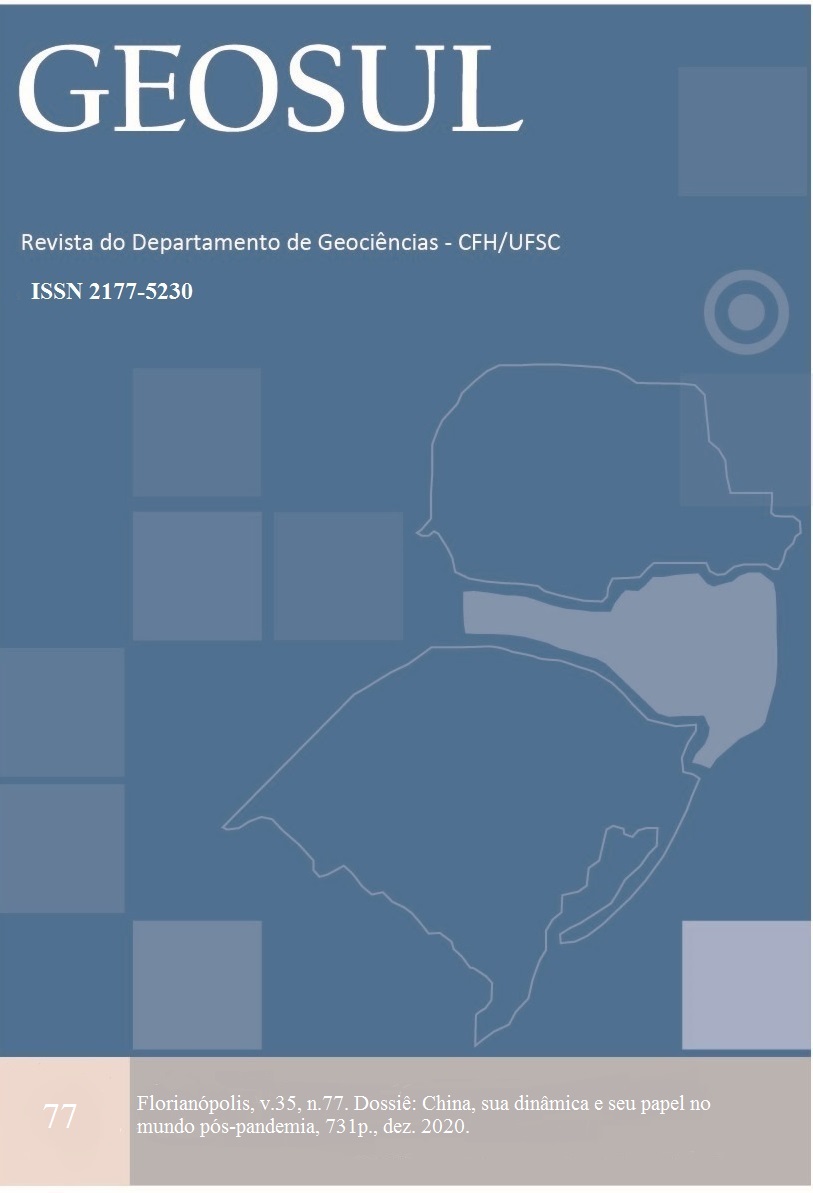Planejamento, inovação e consumo construindo a “Sociedade Harmoniosa” chinesa
DOI:
https://doi.org/10.5007/2177-5230.2020v35n77p270Resumo
Este trabalho busca trazer um panorama das políticas econômico-sociais chinesas responsáveis pelo aumento universal e contínuo de satisfação de seus cidadãos a partir de 2.000 e as movimentações no interior das dinâmicas de acumulação que as orientaram.
Referências
BCG, "Striking a Balance Between Well-Being and Growth: The 2018 Sustainable Economic Development Assessment", Setembro de 2018.
CHEN, Ling; NAUGHTON. Barry. An institutionalized policy-making mechanism: China’s return to techno-industrial policy. Research Policy, v. 45, n. 10, out. 2016. Disponível em: http://www.sciencedirect.com/science/article/pii/S0048733316301482. Acesso em: 10/03/2019
China eleventh five-year plan (2006-2010): From ‘‘Getting Rich First’’ to ‘‘Common Prosperity.’’ Eurasian Geography and Economics, v. 47, n. 6, 2006, p. 708-723.
China Power Team. "Quão bem está a classe média da China?" China Power. 26 de abril de 2017. Atualizado em 26 de agosto de 2020. Acessado em 28 de setembro de 2020. https://chinapower.csis.org/china-middle-class/. Acesso em 30/09/2020
Conferência Nacional de Política Externa e Política Internacional - III CNPEPI : (2 : Rio de Janeiro : 2008) : O Brasil no mundo que vem aí. Seminário : China - Brasília : Fundação Alexandre de Gusmão, 2008.
Conselho de Estado. Alívio e desenvolvimento da pobreza rural na China. Pequim. 2001.
Conselho de Estado. Relatório de trabalho do governo. Pequim. 2006.
Correctly Grasp the Evolution of the Principal Contradiction Facing Chinese Society. November 27, 2017. Disponível em: http://en.theorychina.org/xsqy_2477/201801/t20180103_360967.shtml. Acesso em 30/09/2020
Deakin, Simon (2016) The Contribution of Labour Law to Economic Development and Growth, Working Paper No. 478, Centre for Business Research, University of Cambridge.
ENLAI, Zhou. Selected Works of Zhou Enlai.Turning China into a powerful, modern, socialist, industrialized country.Foreign Language Press.Bijing, China. 1989.
Fighting COVID-19: China in Action. http://english.www.gov.cn/news/topnews/202006/07/content_WS5edc559ac6d066592a449030.html. Acesso em 30/09/2020
Fortune. Disponível em: http://fortune.com/global500/2020/search/?rankchange=desc&rankgain=true. Acesso em 30/9/2020
GABRIELE, Alberto. Enterprises, Industry and Innovation in the People’s Republic of China: Questioning Socialism from Deng to the Trade and Tech War. Springer Nature, 2020. P.15
HOFMAN, Bert. Reflections on Forty Years of China’s Reforms Speech at the Fudan University’s Fanhai School of International Finance.World Bank. Jan. 2018. Disponível em: http://pubdocs.worldbank.org/en/934911517472447837/Reflections-on-40-years-of-reforms-final.pdf. Acesso em: 14/03/2019.
HU, A. Envisaging China’a grand strategy: The ambitious goal of a prosperous people and a powerful nation. Social Sciences in China, Winter, 2005, p. 87-99
Hu, ZHENGYI, “Wen Explains Proposal on 11th 5-Year Plan, Gov.cn, October 20, 2005 http://english.gov.cn/2005-10/20/content_80097.htm Acesso em 30/09/2020
INSTITUTO DE ESTUDOS PARA O DESENVOLVIMENTO INDUSTRIAL. A transformação da china em economia orientada à inovação. 2011. Disponível em: http://www.ipdeletron.org.br/wwwroot/pdf-publicacoes/17/A_transformacao_da_China_em_Economia_Orientada_a_Inovacao.pdf. Acesso em: 13/03/2019
International Labor Organization (ILO). 2018. Global Wage Report 2018 / 19: What Lies Behind Gender Pay Gaps. https://www.ilo.org/global/publications/books/WCMS_650553/lang--en/index.htm Acesso em 3/09/2020
JABBOUR, Elias; DANTAS, Alexis. The political economy of reforms and the present Chinese transition. Brazilian Journal of Political Economy, v. 37, n. 4, p. 789-807, 2017.
JABBOUR, Elias; PAULA, Luiz Fernando de. A China e a “socialização do investimento”: uma abordagem Keynes-Gerschenkron-Rangel-Hirschman. Revista de Economia Contemporânea, v. 22, n. 1, 2018.
LO, Dic. “China’s Quest for an Alternative to Neo-Liberalism: Market Reform, Economic Growth and Labour”, Kyoto Economic Review, 2017. 76 (2): 193-210. P. 201. Also available as Department of Economics Working Paper No. 153, SOAS, http://www.soas.ac.uk/economics/research/workingpapers Acesso em 30/09/2020
LO, Dic. “China’s Quest for an Alternative to Neo-Liberalism: Market Reform, Economic Growth and Labour”, Kyoto Economic Review, 2017. 76 (2): 193-210. P. 201. Also available as Department of Economics Working Paper No. 153, SOAS, http://www.soas.ac.uk/economics/research/workingpapers
MCKINNON, Ronald; SCHNABL, Gunther. China: a stabilizing or deflationary influence in East Asia? The problem of conflicted virtue. 2003.
MEDEIROS, Carlos A. Padrões de investimento, mudança institucional e transformação estrutural na economia chinesa. Padrões de desenvolvimento econômico: América Latina, Ásia e Rússia (1950-2008). Brasília: CGEE, 2013.
MEDEIROS, Carlos Aguiar de. A China como um duplo pólo na economia mundial e a recentralização da economia asiática. Brazilian Journal of Political Economy, v. 26, n. 3, p. 381-400, 2006. P. 387
MGI, “China and the world: Inside the dynamics of a changing relationship”, July 2019.
MIMI, Z. O. U. Economic Development and the “Social Rights Hypothesis”: Regulating Labour Standards in China. Asian Journal of Law and Society, v. 5, n. 2, p. 315-331, 2018.
Naughton, B. (2018). The Chinese economy: Adaptation and growth (2nd ed.). Cambridge, MA: MIT. P.1
NGOK, Kinglun. The changes of Chinese labor policy and labor legislation in the context of market transition.International Labor and Working-Class History, v. 73, n. 1, p. 45-64, 2008.
NOTÍCIAS do Partido Comunista. Ciência e tecnologia são as principais forças produtivas. Disponível em: http://dangshi.people.com.cn/GB/221024/221027/14907120.html Acesso em: 1012/2018.
Relatório da Missão Conjunta OMS-China sobre doença por Corona Vírus 2019 (Covid-19), 28 de fevereiro, 2020. http://www.who.int/publications-detail/report-of-the-who-china-joint-mission-on-coronavirus-doença-2019- (covid-19). Acesso em 30/09/2020.
The 10th Five-Year Plan (2001-2005), 2006. Disponível em: http://www.gov.cn/english/2006-04/05/content_245624.htm Acesso em: 10/03/2019.
The 16th National Congress. ovember 8-14, 2002. Disponível em: https://cpcchina.chinadaily.com.cn/2010-09/07/content_15842546.htm Acesso em 30/09/2020
The 6th Five-Year Plan (1981-1985), 2006. Disponível em: http://www.gov.cn/english/2006-04/05/content_245699.htm. Acesso em: 10 mar. 2019.
Understanding CCP Resilience – p.9 Disponível em: http://www.chinadaily.com.cn/a/201903/27/WS5c9b97eda3104842260b2f05.html Acesso em 30/09/2020
WENZHANG, Zhou. “Onde está o mistério do grande sucesso da China em reforma e abertura?”. 2019. Disponível em: http://theory.people.com.cn/n1/2019/0122/c148980-30583103.html. Acesso em 03/03/2019
WIPO, Cornell University and INSEAD, “The Global Innovation Index 2019”, Julho 2020.
Xinhua News Agency.” Made in China 2025" is not a replica of German Industry 4.0 - China Academy of Engineering launched the second phase of the "Strategy for Manufacturing a Powerful Country". Beijing. 2015
Xinhuanet. Economic Watch: A new epic - Chinese economy in 2020s. Disponível em: http://www.xinhuanet.com/english/2020-01/19/c_138718792.htm Acesso em 30/09/2020.
Downloads
Publicado
Edição
Seção
Licença

Este trabalho está licenciado com uma Licença Creative Commons - Atribuição 4.0 Internacional.


